Charles River
| Charles River | |
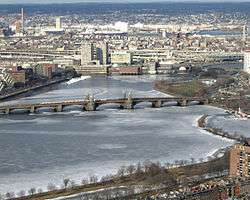 The Longfellow Bridge crossing over the Charles River, in winter | |
| Country | United States |
|---|---|
| State | Massachusetts |
| Cities | Hopkinton, Cambridge, Boston |
| Source | Echo Lake |
| - location | Hopkinton, Massachusetts, United States |
| - elevation | 350 ft (107 m) |
| - coordinates | 42°11′34″N 71°30′43″W / 42.19278°N 71.51194°W |
| Mouth | Boston Harbor |
| - location | Boston, Massachusetts, United States |
| - elevation | 0 ft (0 m) |
| - coordinates | 42°22′14″N 71°3′13″W / 42.37056°N 71.05361°WCoordinates: 42°22′14″N 71°3′13″W / 42.37056°N 71.05361°W |
| Length | 80 mi (129 km) |
| Basin | 308 sq mi (798 km2) |
| Discharge | |
| - average | 302 cu ft/s (9 m3/s) |
| - max | 4,150 cu ft/s (118 m3/s) |
| - min | 0.1 cu ft/s (0 m3/s) |
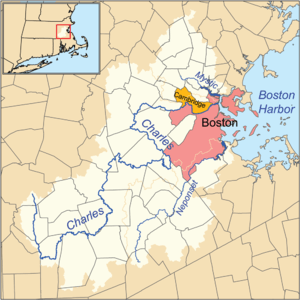 Charles, Mystic, and Neponset river watersheds
| |
The Charles River (sometimes called the River Charles or simply the Charles) is an 80 mi (129 km) long river in eastern Massachusetts. From its source in Hopkinton the river flows in a northeasterly direction (after first coursing due south through Milford), traveling through 23 cities and towns before reaching the Atlantic Ocean at Boston.[1]
Hydrography
The Charles River is fed by approximately 80 streams and several major aquifers as it flows 80 miles (129 km),[2] starting at Teresa Road just north[3] of Echo Lake (42°12′54″N 71°30′52″W / 42.215°N 71.514444°W) in Hopkinton, passing through 23 cities and towns in eastern Massachusetts before emptying into Boston Harbor.[1] Thirty-three lakes and ponds and 35 communities are entirely or partially part of the Charles River drainage basin. Despite the river's length and relatively large drainage area (308 square miles; 798 km²), its source is only 26 miles (42 km) from its mouth, and the river drops only 350 feet (107 m) from source to sea. The Charles River watershed contains over 8,000 acres of protected wetlands, referred to as Natural Valley Storage. These areas are important in preventing downstream flooding and providing natural habitats to native species.
Brandeis University, Harvard University, Boston University, and the Massachusetts Institute of Technology are located along the Charles River. Near its mouth, it forms the border between downtown Boston and Cambridge and Charlestown. The river opens into a broad basin and is lined by the parks of the Charles River Reservation. On the Charles River Esplanade stands the Hatch Shell, where concerts are given in summer evenings. The basin is especially known for its Independence Day celebration. The middle section of the river between the Watertown Dam and Wellesley is partially protected by the properties of the Upper Charles River Reservation and other state parks, including the Hemlock Gorge Reservation, Cutler Park, and the Elm Bank Reservation.
Recreation
The river is well known for its rowing, sculling, dragonboating, and sailing, both recreational and competitive. The river may also be kayaked; depending on the season, however, kayakers can only navigate the Charles by getting out and dragging their kayaks for significant stretches. The "Lower Basin" between the Longfellow and Harvard bridges is home to Community Boating, the Harvard University Sailing Center, and the MIT Sailing Pavilion. The Head of the Charles Regatta is held here every October. In early June, the annual Hong Kong Boston Dragon boat Festival is held in Cambridge, near the Weeks Footbridge.
The Charles River Bike Path runs 23 miles (37 km) along the banks of the Charles, starting at the Museum of Science and passing the campuses of MIT, Harvard and Boston University. The path is popular with runners and bikers. Many runners gauge their distance and speed by keeping track of the mileage between the bridges along the route.[4]
For several years, the Charles River Speedway operated along part of the river.
On July 13, 2013, swimming for the general public was permitted for the first time in more than 50 years.[5]
History
.jpg)
The river's name, preceding the English version, was once thought to be Quinobequin (meandering), though that attribution has been discredited by, among others, the Harvard University Librarian in 1850. The river was used by Native Americans for local transportation and fishing and as part of the passage from southeastern Massachusetts to northern New England.
Captain John Smith explored and mapped the coast of New England, naming many features, originally naming the Charles River the Massachusetts River, which was derived from the tribe living in the region. When Smith presented his map to Charles I he suggested that the king should feel free to change any of the "barbarous names" for "English" ones. The king made many such changes, but only four survive today, one of which is the Charles River which Charles named for himself.[6]
In portions of its length, the Charles drops slowly in elevation and has relatively little current. Despite this, early settlers in Dedham, Massachusetts, found a way to use the Charles to power mills. In 1639, the town dug a canal from the Charles to a nearby brook that drained to the Neponset River. By this action, a portion of the Charles's flow was diverted, providing enough current for several mills. The new canal and the brook together are now called Mother Brook. The canal is regarded as the first industrial canal in North America. It remains in use for flood control.
Waltham was the site of the first fully integrated textile factory in America, built by Francis Cabot Lowell in 1814,[7] and by the 19th century the Charles River was one of the most industrialized areas in the United States. Its hydropower soon fueled many mills and factories. By the century's end, 20 dams had been built across the river, mostly to generate power for industry. An 1875 government report listed 43 mills along the 9.5-mile (15 km) tidal estuary from Watertown Dam to Boston Harbor.
From 1816 to 1968, the U.S. Army operated a gun and ammunition storage and later production facility known as the Watertown Arsenal. While it was key to many of the nation's war efforts over its several decades in operation, not the least of which being the American Civil War and World War I, its location in Watertown so near the Charles did great environmental harm. The arsenal was declared a Super Fund site, and after its closure by the government it had to be cleaned at significant expense before it could be safely used again for other purposes. Likewise, the many factories and mills along the banks of the Charles supported a buoyant economy in their time but left a legacy of massive pollution.
Creation of modern Boston-Cambridge basin
Today's Charles River basin between Boston and Cambridge is almost entirely a work of human design. Owen A. Galvin was appointed head of the Charles River Improvement Commission by Governor William E. Russell in 1891. Their work led to the design initiatives of noted landscape architects Charles Eliot and Arthur Shurcliff, both of whom had apprenticed with Frederick Law Olmsted and Guy Lowell. This designed landscape includes over 20 parks and natural areas along 19 miles (31 km) of shoreline, from the New Dam at the Charlestown Bridge to the dam near Watertown Square.
Eliot first envisioned today's river design in the 1890s, an important model being the layout of the Alster basin in Hamburg,[8] but major construction began only after Eliot's death with the damming of the river's mouth at today's Boston Museum of Science, an effort led by James Jackson Storrow. The new dam, completed in 1910, stabilized the water level from Boston to Watertown, eliminating the existing mud flats, and a narrow embankment was built between Leverett Circle and Charlesgate. After Storrow's death, his widow Mrs. James Jackson Storrow donated $1 million toward the creation of a more generously landscaped park along the Esplanade; it was dedicated in 1936 as the Storrow Memorial Embankment. This also enabled the construction of many public docks in the Charles River Basin. In the 1950s a highway (Storrow Drive) was built along the edge of the Esplanade to connect Charles Circle with Soldiers Field Road, and the Esplanade was enlarged on the water side of the new highway.
The Inner Belt highway was proposed to cross the Charles River at the Boston University Bridge, but its construction was canceled in the 1970s.
History of pollution and remediation efforts
As sewage, industrial wastewater and urban runoff flowed freely into the river from the surrounding city, the Charles River became well known for its high level of pollutants, gaining such notoriety that by 1955, Bernard DeVoto wrote in Harper's Magazine that the Charles was "foul and noisome, polluted by offal and industrious wastes, scummy with oil, unlikely to be mistaken for water."[9] It was not an uncommon sight to see toxins coloring parts of the river pink and orange, fish kills and submerged cars.[10]
Once popular with swimmers, awareness of the river's high pollution levels forced the state to shut down several popular swimming areas, including Cambridge's Magazine Beach and Gerry Landing public beaches.[9][11]

Efforts to clean up the river and restore it to a state where swimming and fishing would be acceptable began as early as the 1960s, and the program to clean up the Charles for good took shape in 1965 with the creation of the Charles River Watershed Association.[12] In 1978, a new Charles River Dam was constructed downstream from the Science Museum site to keep salt water out of the basin.
In 1995, the United States Environmental Protection Agency declared a goal of making the river swimmable by 2005.[9] In 1996, Governor William Weld plunged, fully clothed, into the river to prove his commitment to cleaning up the river.[13] On November 12, 2004, Christopher Swain became the first person to swim the Charles River's entire length, in an effort to raise public awareness of the river's environmental health.[14][15][16] In July 2007, the river hosted the Charles River Masters Swim Race, the first sanctioned race in the Charles in over five decades.[17]
A combination of public and private initiatives helped dramatically lower levels of pollutants by focusing on eliminating combined sewer overflows and storm water runoff. Since Weld's stunt, the river's condition has improved dramatically, although it was not deemed entirely swimmable by 2005.
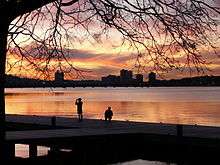
The Conservation Law Foundation opposes the permit given to Mirant for the Veolia Energy North America Kendall Cogeneration Station, an electricity plant near Kendall Square, charging that the water it releases causes blooms of hazardous microorganisms because of its warm temperature.[18]
The water quality of the Charles River is often at its worst after a large rainfall because of pollutants carried by runoff, and sewage overflows. For 2011, the EPA reported that the Charles met state bacterial standards for boating and swimming 96% and 89% of the time on dry days, and 74% and 35% of the time on wet days, respectively.[19] Overall boatability and swimability of 82% and 54% in 2011 compare with 39% and 19% in 1995.
A study published in the Journal of the American Water Resources Association in April 2008 and completed by researchers at Northeastern University, found high concentrations of E. coli bacteria in the Charles River after a long period of no rain. Using a mathematical model, the researchers then determined that two major tributaries, the Stony Brook and Muddy River, are the predominant sources of E. coli in the lower Charles River.[20]
Oysters have been used to filter and clean Charles River water.[21]
As of 2013, boating is allowed on the Charles but swimming without a permit is punishable by a fine up to $250.[22] Starting in 2007,[23] the Charles River Swimming Club has organized an annual race for its members, but obtains a special permit and must monitor water quality and rainfall in the days leading up to the race.[24] The "first public swim" in the Charles since the 1950s was conducted on July 13, 2013, by the Charles River Conservancy, CWRA, Esplanade Association, and DCR.[25] Both the annual race[26] and the Conservancy event have been held in deep water with swimmers jumping in off a dock, to avoid the toxic sediments on the bottom of the river that still make beach swimming dangerous.[27]
Gallery
-
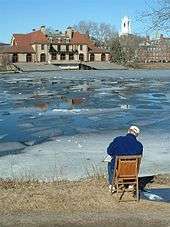
The Charles River from the Boston side, facing Weld Boathouse and the main campus of Harvard University in Cambridge.
-
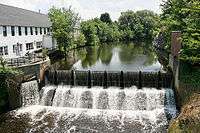
View of Charles River at Newton Upper Falls
-
Charles River under Echo Bridge in Newton
-
Charles River at Medfield-Millis town line
-
Charles River basin from an office tower in Boston.
-

Charles River Esplanade, 2013
-
Charles River Esplanade, 2013
-

View of the Charles River and Downtown Boston from the Boston University Bridge
-

John W. Weeks Bridge
See also
- List of crossings of the Charles River
- List of Charles River boathouses
- List of rivers of Massachusetts
- Sudbury Aqueduct Linear District which crosses the river from Needham to Newton on the Echo Bridge
Notes
- 1 2 "Charles River Watershed". The Charles River Watershed Association. Retrieved February 5, 2013.
- ↑ Archived July 7, 2011, at the Wayback Machine.
- ↑ http://geonames.usgs.gov/apex/f?p=gnispq:3:::NO::P3_FID:619357
- ↑ "Charles River Mileage Map/Table". Web.mit.edu. Retrieved 2012-04-16.
- ↑ Brody, Sharon (2013-07-13). "Public Swim Follows 50 Years Of Dirty Water". WBUR. Retrieved 2013-07-18.
- ↑ Stewart, George R. (1967) [1945]. Names on the Land: A Historical Account of Place-Naming in the United States (Sentry edition (3rd) ed.). Houghton Mifflin. p. 38.
- ↑ "Who Made America? Pioneers: Francis Cabot Lowell". PBS. Retrieved July 30, 2011.
- ↑ Karl Haglund (2003). Inventing the Charles River. Cambridge, Massachusetts: The MIT Press. ISBN 0-262-08307-8.
- 1 2 3 Swimming in the Charles River Archived May 11, 2010, at the Wayback Machine.
- ↑ "Group Eyes Lawsuit Over Charles River Pollution". Boston.com. Retrieved 16 October 2014.
- ↑ "Clear and Clean". Boston.com. Retrieved 16 October 2014.
- ↑ "Charles River Watershed Association". Crwa.org. Retrieved 16 October 2014.
- ↑ "Online NewsHour: KERRY / WELD: DEAD HEAT". PBS NewsHour. Retrieved 16 October 2014.
- ↑ "Person of the Week: Christopher Swain". ABC News. Retrieved 16 October 2014.
- ↑ "Vermont swimmer hates dirty water, but covers entire Charles River in Mass. : Times Argus Online". Timesargus.com. Retrieved 16 October 2014.
- ↑ Mark Clayton (8 November 2004). "An 80-mile swim - with hubcaps". The Christian Science Monitor. Retrieved 16 October 2014.
- ↑ Malcom A. Glenn, Brown Charles Gets Green Light, Harvard Crimson, July 20, 2007
- ↑ "Conservation Law Foundation Secures Groundbreaking Outcome in GenOn Kendall Plant Case - Innovative Solution to Cooling System Issues Will Improve Charles River Health, Bring Lower Carbon Steam Heat and Power to City Buildings". Conservation Law Foundation. 2011-02-02. Retrieved 2015-04-06.
- ↑ "Report Cards - Charles River - New England - US EPA". Epa.gov. Retrieved 16 October 2014.
- ↑ "Researcher Develops Model to Track E. coli in Charles River". Newswise.com. Retrieved 16 October 2014.
- ↑ Beard, David (October 26, 2008). "Oysters help clean the Charles River". The Boston Globe.
- ↑ Swimming and ice skating are prohibited by 350 CMR 12.02 (7) except where posted by the Department of Conservation and Recreation, and as of 2013 there are no posted swimming areas. The maximum fine is set by 350 CMR 12.03.
- ↑ Belluck, Pam (July 22, 2007). "A Boston River Now (Mostly) Fit for Swimming". The New York Times.
- ↑ "FAQs". Retrieved 2013-07-30.
- ↑ "Charles River opens for first public swim since the 1950s". The Boston Globe.
- ↑ "Charles River Swimming Club, Inc. : Maps". Charlesriverswimmingclub.org. Retrieved 16 October 2014.
- ↑ "Public Swim Follows 50 Years Of Dirty Water". WBUR. 13 July 2013. Retrieved 16 October 2014.
References
- Inventing the Charles River, by Karl Haglund, MIT Press, 2003, in collaboration with the Charles River Conservancy. ISBN 0-262-08307-8.
- Gaining Ground: A History of Landmaking in Boston, by Nancy S. Seasholes, MIT Press, 2003. ISBN 978-0262194945.
- Omeros, by Derek Walcott, Faber and Faber (London), 1990. ISBN 978-0374523503 (Repeated references to the Charles river in descriptions of Boston life.)
- Tourtellot, Arthur Bernon (2014) [1941]. Benet, Stephen Vincent; Carmer, Carl, eds. The Charles. Rivers of America. Mineola, N.Y.: Dover Publications. ISBN 9780486492940. OCLC 990111.
External links
| Wikimedia Commons has media related to Charles River. |
| Wikisource has the text of the 1879 American Cyclopædia article Charles River. |
- The Esplanade Association
- Charles River Watershed Association
- Charles River Conservancy
- MA Department of Conservation and Recreation - Charles River Reservation
- "Swimmable by 2005" EPA Effort
- Charles River Swimming Club
- Charles River Museum of Industry
- U.S. Geological Survey data on flow in Charles River at various measurement points
- US Geological Survey Report on The Charles River Restoration
-
 "Charles River". New International Encyclopedia. 1905.
"Charles River". New International Encyclopedia. 1905.